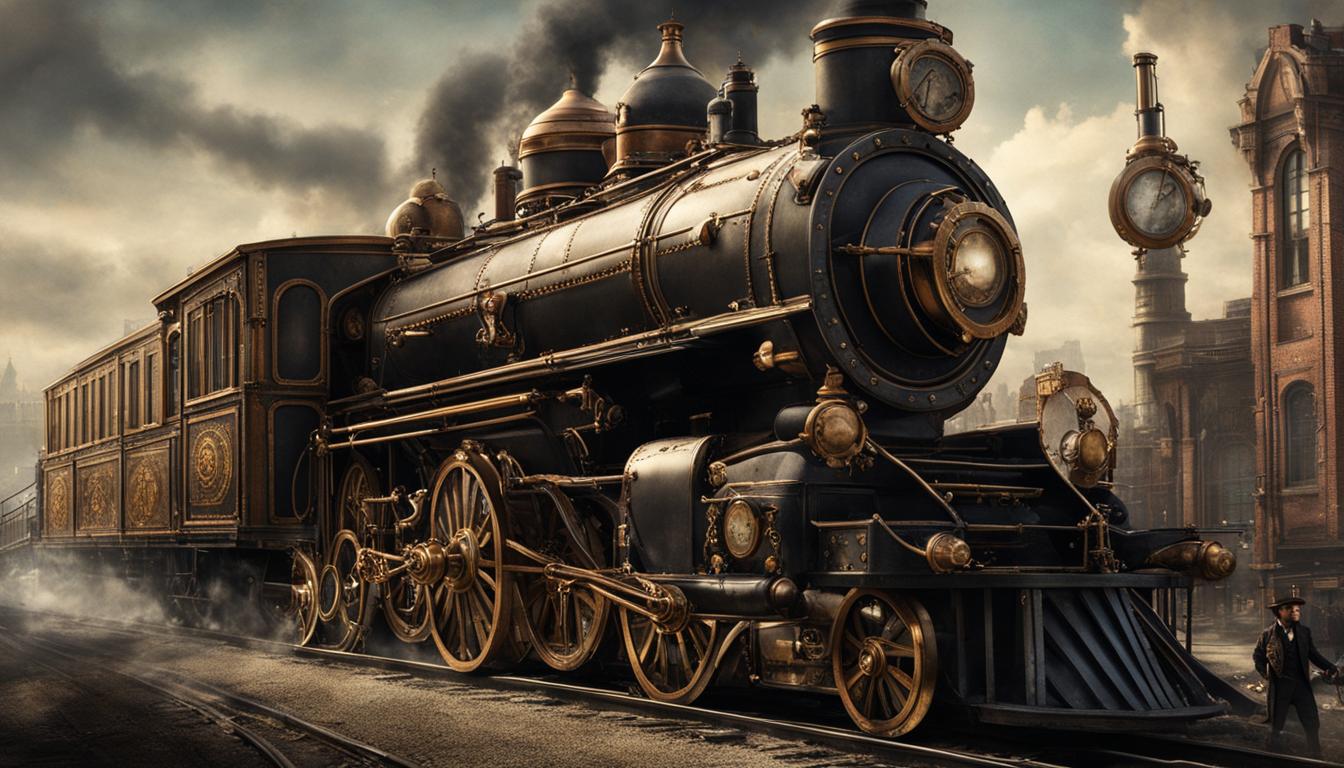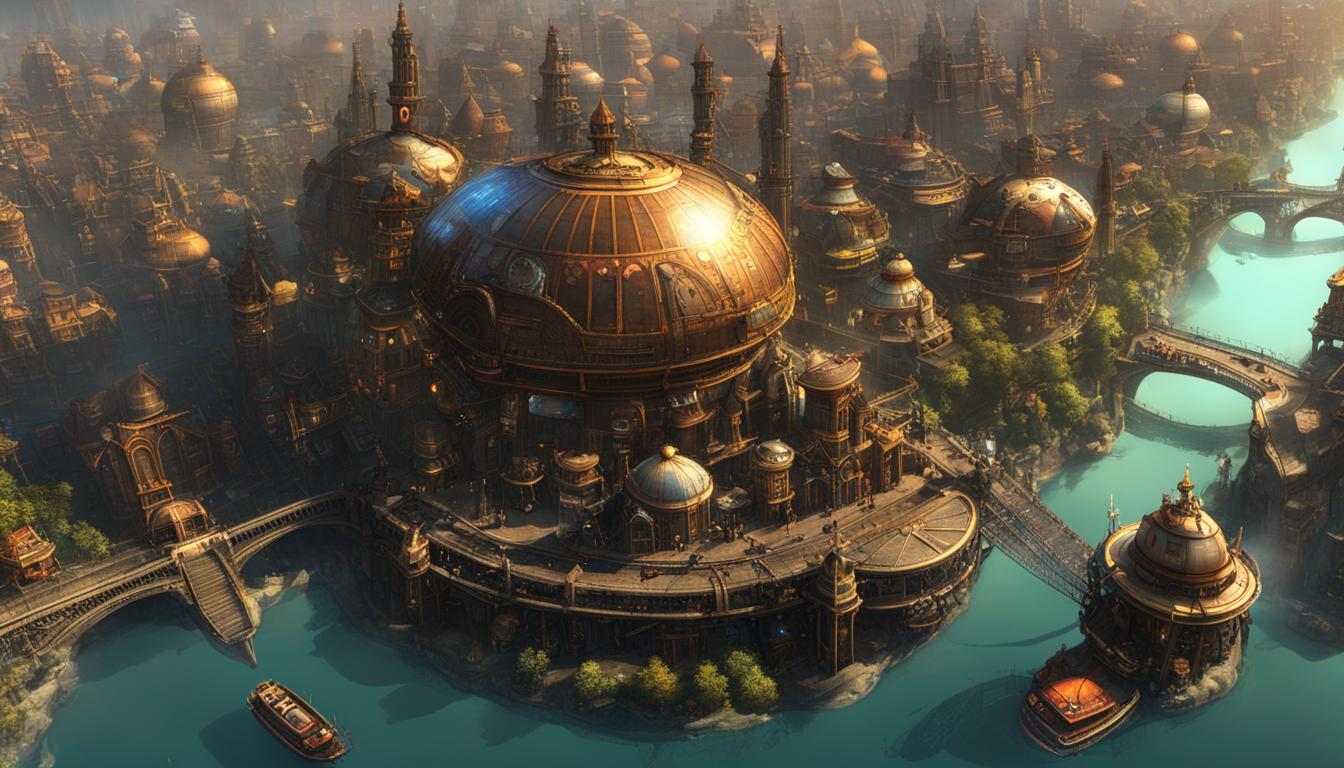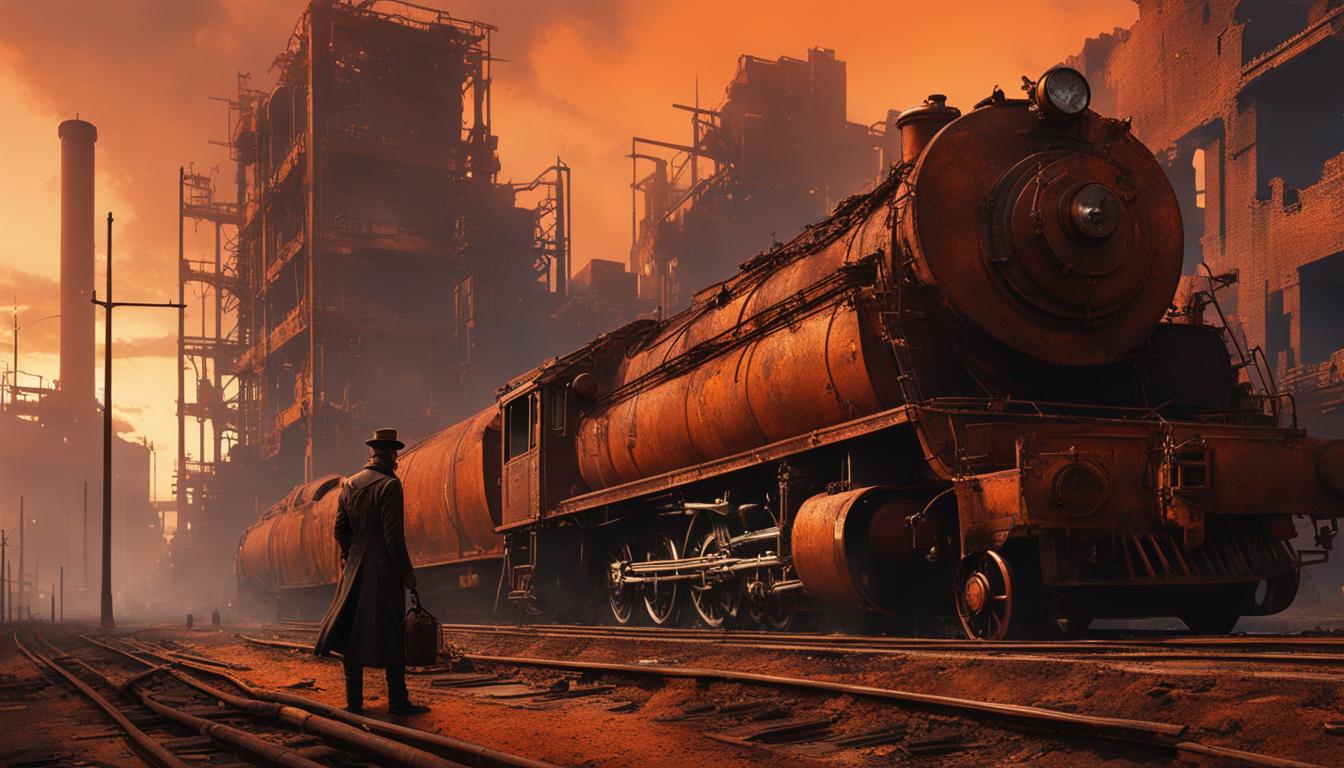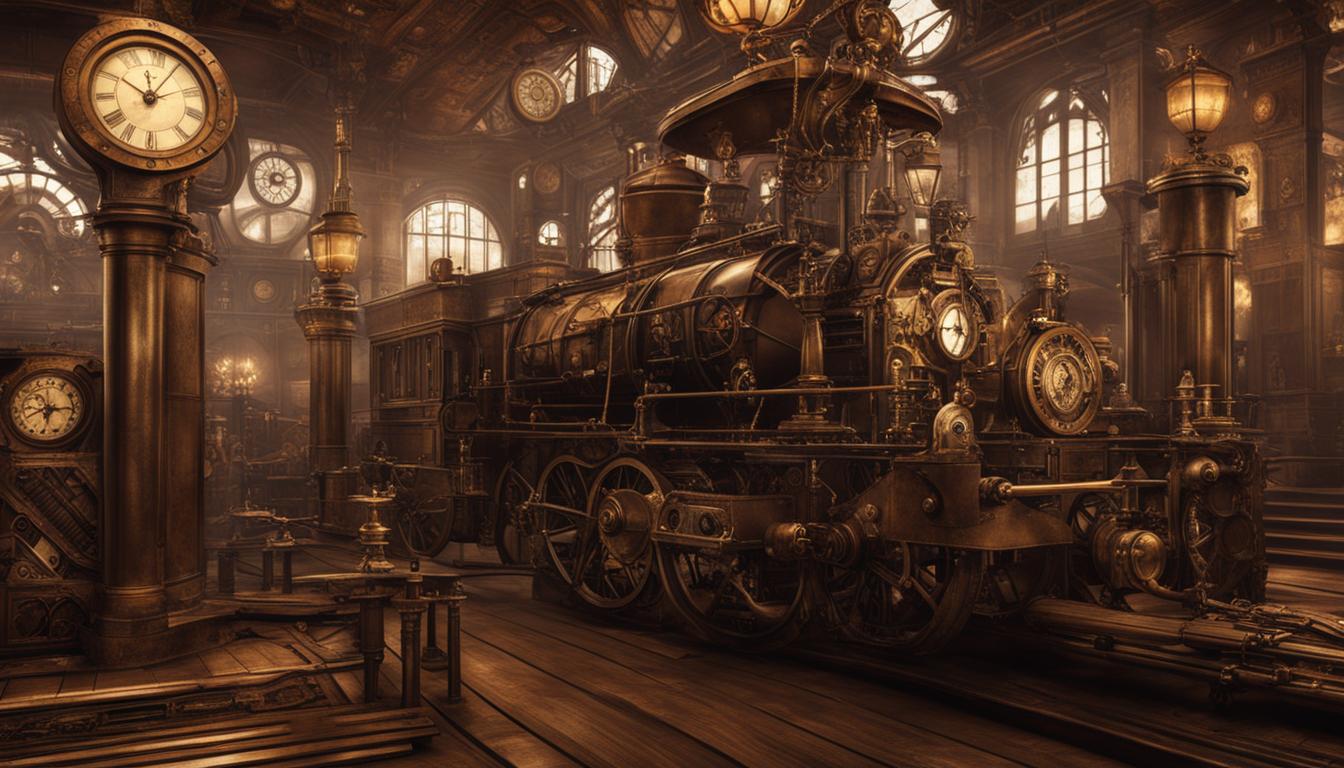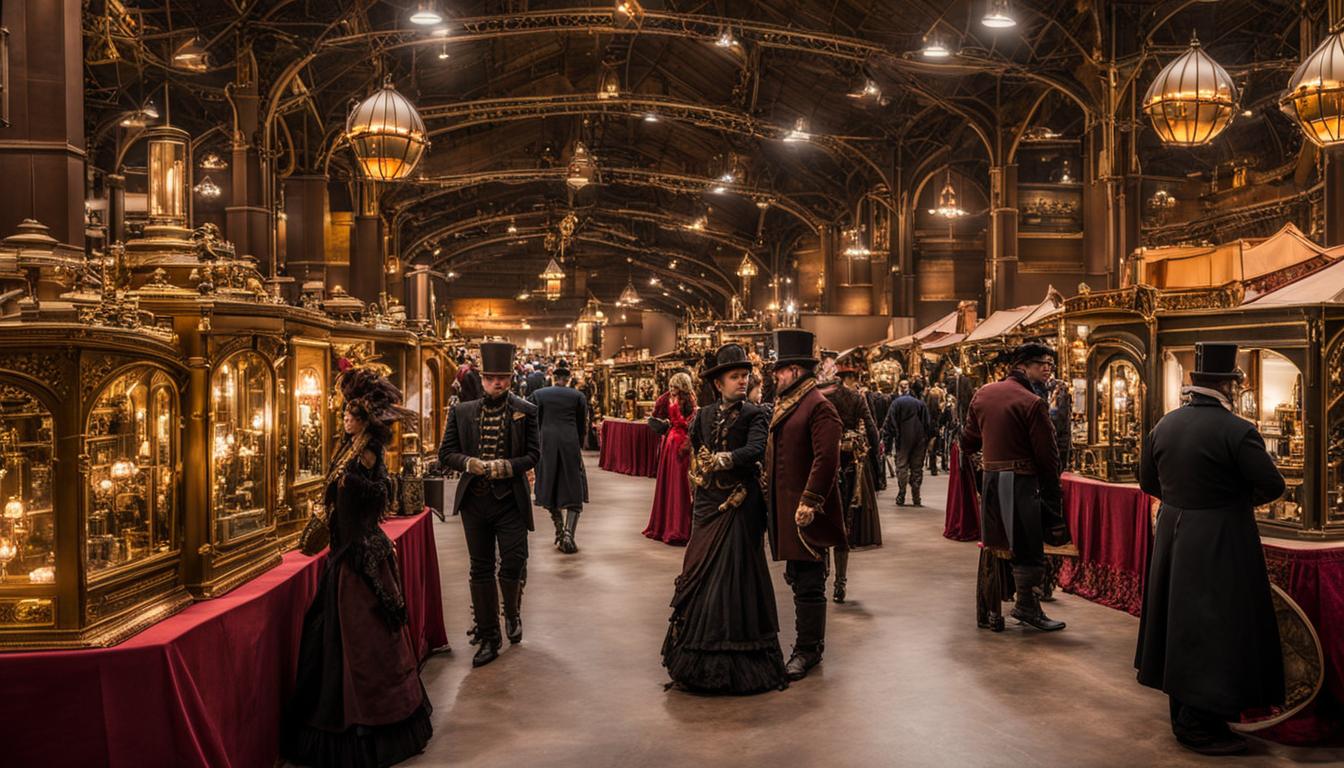Step into a world where the past collides with the future, where Victorian elegance meets steam-powered innovation. This is the realm of steampunk, a subculture that has left an indelible mark on modern cinema. With its unique aesthetic, alternative history, and imaginative storytelling, steampunk has captivated audiences and transformed the way we experience film.
Steampunk takes us back to the era of the Industrial Revolution, reimagining a Victorian England infused with wild west elements and fantastical steam-powered science fiction. This creative conceptualization has not only influenced the visual design of movies but also the themes and cinematography techniques used to convey stories on the big screen.
From the intricate gears and open-faced machinery to the corsets, top hats, and goggles, steampunk has crafted a distinct fashion statement that has permeated the subculture and even spilled over into high fashion brands. With its emphasis on DIY craftsmanship and resourcefulness, steampunk has become more than just a style; it’s a movement that challenges the homogenization of technology.
Through steampunk cinema, we delve into themes of commodification, DIY culture, and globalization. It explores the commercialization of the subculture, the power of individuality and personal expression, and the global connections that have allowed steampunk to transcend borders. As a result, steampunk has not only captured our imaginations; it has also had a profound social and cultural impact.
Key Takeaways:
- Steampunk has revolutionized modern cinema with its unique aesthetic and storytelling style.
- It combines elements of the Victorian era, the Wild West, and steam-powered science fiction.
- The steampunk aesthetic has influenced fashion, high-end brands, and other subcultures.
- Steampunk cinema explores themes of commodification, DIY culture, and globalization.
- Steampunk has had a profound social and cultural impact, inspiring creativity and individuality.
The History and Origin of Steampunk
Steampunk, with its distinct retro-futuristic aesthetic and alternative history, has captured the imagination of people worldwide. The origins of steampunk can be traced back to the 1900s when it emerged as a subgenre of science fiction literature. In contrast to cyberpunk, steampunk focused on clockwork mechanisms, nineteenth-century machinery, and the Victorian era. It envisioned a universe where steam power remained the dominant form of energy, creating an alternative future to our own.
Combining elements of the Victorian era and the Wild West, steampunk weaves together an intricate tapestry of fashion, technology, and storytelling. The subculture draws inspiration from the ornate architecture, fashion, and societal norms of the Victorian era, while also incorporating the ruggedness and adventure of the Wild West. This unique blend of influences has led to the development of a rich and visually captivating aesthetic.
Steampunk’s rise in popularity can be attributed to its ability to transport audiences to a bygone era filled with imaginative contraptions, airships, and steam-powered machinery. It has evolved into a global phenomenon, capturing the hearts of enthusiasts from all walks of life. The fusion of Victorian elegance, retro-futuristic technology, and steam-powered science fiction continues to captivate, providing a boundless source of inspiration for artists, filmmakers, and creators.
Steampunk Fashion: A Fusion of Elegance and Machinery
At the heart of steampunk lies its distinctive fashion, which effortlessly blends the elegance of the Victorian era with the mechanical ingenuity of an alternate industrial revolution. Steampunk enthusiasts embrace corsets, top hats, goggles, and other accessories adorned with gears, hydraulics, and exposed machinery. The color palette often consists of rich jewel tones, complemented by the earthy hues of black, brown, leather, copper, and brass.
Steampunk Cinema: A Visual and Narrative Journey
The influence of steampunk extends beyond the boundaries of literature and into the realm of cinema, where its visual and narrative elements have left an indelible mark. Movies such as “Treasure Planet,” “Wild Wild West,” and “The League of Extraordinary Gentlemen” showcase the alternative history, retro-futuristic technology, and intricate visual design synonymous with steampunk. These films transport audiences to imaginative worlds where dirigibles rule the skies and steam-powered contraptions drive the plot.
| Steampunk Elements in Cinema | Examples |
|---|---|
| Visual Design | “Treasure Planet,” “Wild Wild West,” “The League of Extraordinary Gentlemen” |
| Alternative History | “Sherlock Holmes,” “Sucker Punch,” “The Golden Compass” |
| Retro-futuristic Technology | “Hugo,” “City of Ember,” “Stardust” |
The Aesthetic of Steampunk Cinema
The steampunk aesthetic is a visual feast that combines elements of Victorian-era fashion with uncovered machinery, creating a unique and captivating style. Steeped in nostalgia and fantasy, steampunk fashion showcases an array of iconic attire, including corsets, top hats, goggles, and open-faced gears, hydraulics, and engines. The color palette often includes deep jewel tones, black, brown, and accents of leather, copper, and brass. Steampunk fashion has not only influenced other subcultures, such as burlesque and goth groups, but it has also made its way into high fashion brands, enchanting fashionistas with its eclectic blend of history and innovation.
The incorporation of weapons as accessories adds an air of adventure and intrigue to the overall aesthetic. These unique fashion choices reflect the steampunk subculture’s emphasis on individuality, creativity, and DIY craftsmanship. Steampunk enthusiasts often design and create their own clothing and accessories, showcasing their resourcefulness and originality. This dedication to handmade craftsmanship is a core aspect of the steampunk subculture, reflecting a resistance against the homogenization of modern technology. Steampunk fashion not only tells a story but also invites individuals to express their own narratives through their attire.
“Steampunk fashion is an art form that allows us to blend history and imagination, creating a whimsical yet sophisticated style that transcends time and captivates the imagination.” – Fashion Designer Annette Corrigan
The Evolution of Steampunk Fashion
- Victorian Era Inspiration: The steampunk aesthetic draws heavily from the fashion of the Victorian era, with its emphasis on structured silhouettes and intricate details.
- Experimental Accessories: Steampunk fashion embraces unique accessories such as pocket watches, compasses, and mechanical contraptions, adding a hint of adventure and curiosity to any ensemble.
- Combining Past and Future: Steampunk fashion seamlessly blends historical elements with futuristic concepts, creating a visually striking juxtaposition that appeals to the imagination.
- Handmade Craftsmanship: The DIY culture of the steampunk subculture encourages individuals to create their own fashion pieces, incorporating repurposed materials and showcasing their ingenuity.
Steampunk fashion not only transports us to an alternative past but also challenges the boundaries of modern fashion. Its blend of history, innovation, and individuality continues to inspire and captivate fashion enthusiasts around the world.
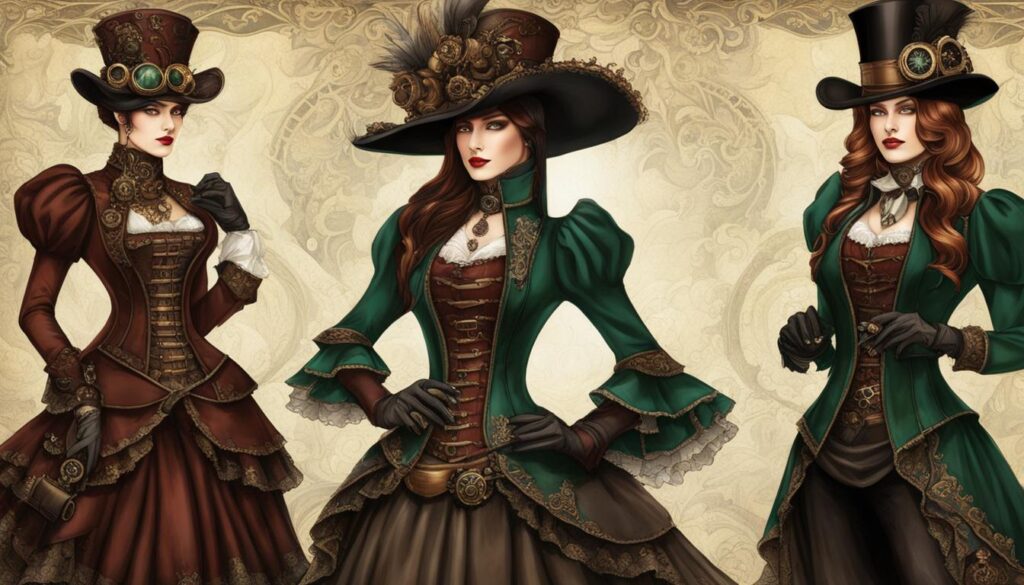
Themes in Steampunk Cinema
The world of steampunk cinema explores a multitude of captivating themes that delve into the societal implications of this alternative retro-futuristic genre. From the commodification of steampunk as a subculture to the emphasis on DIY culture and the impact of globalization, these themes offer thought-provoking insights into the sociological significance of steampunk.
One prevalent theme in steampunk cinema is commodification. As the subculture gains popularity, there is a risk of commercialization diluting its essence. This theme highlights the tension between the authenticity and commercial viability of steampunk aesthetics and ideas.
“Steampunk allows us to explore the tension between creativity and commodification in a visually striking and thought-provoking way.”
Another central theme in steampunk cinema is the celebration of DIY (do-it-yourself) culture. Steampunk embodies a resourceful and inventive spirit, emphasizing the importance of originality and resistance against the homogenization of technology. It showcases a world where individuals take control and forge their own path in a society heavily influenced by mass production and conformity.
Lastly, steampunk cinema often reflects the impact of globalization on the subculture. With the growth of technology and communication, the steampunk aesthetic has spread across borders, allowing for international connections and creative collaborations. This theme highlights the diverse influence of different cultures on the development and evolution of steampunk.
Steampunk Themes:
- Commodification of steampunk as a subculture
- Emphasis on DIY culture and creativity
- Impact of globalization on the spread of steampunk
| Theme | Description |
|---|---|
| Commodification | The tension between commercial viability and authenticity in steampunk |
| DIY Culture | The celebration of resourcefulness, originality, and resistance |
| Globalization | The influence of different cultures on the evolution of steampunk |
In conclusion, the themes explored in steampunk cinema delve into the deeper cultural and societal implications of this captivating subculture. From the challenges of commodification to the celebration of DIY culture and the impact of globalization, steampunk cinema offers a unique lens through which we can explore these thought-provoking ideas.
Steampunk in Media: Movies and Documentaries
Steampunk has left an indelible mark on the world of media, making its presence felt in numerous movies and documentaries. These films and documentaries showcase the rich visual design, alternative history, and retro-futuristic technology that are trademarks of the steampunk genre. From epic adventures to thought-provoking stories, steampunk movies have captivated audiences with their unique blend of nostalgia, fantasy, and innovation.
One notable example of steampunk in cinema is “Treasure Planet,” a Disney animated film that reimagines the classic story of Treasure Island in a futuristic, steam-powered universe. With its stunning visuals and compelling characters, the movie embodies the essence of steampunk and has garnered a dedicated fanbase.
“The League of Extraordinary Gentlemen” is another film that incorporates steampunk elements into its storytelling. Set in an alternative Victorian era, the movie brings together iconic literary characters such as Allan Quartermain, Captain Nemo, and the Invisible Man to form an extraordinary league. The film’s imaginative depiction of steam-powered inventions and its reimagining of classic literature have made it a cult favorite among steampunk enthusiasts.
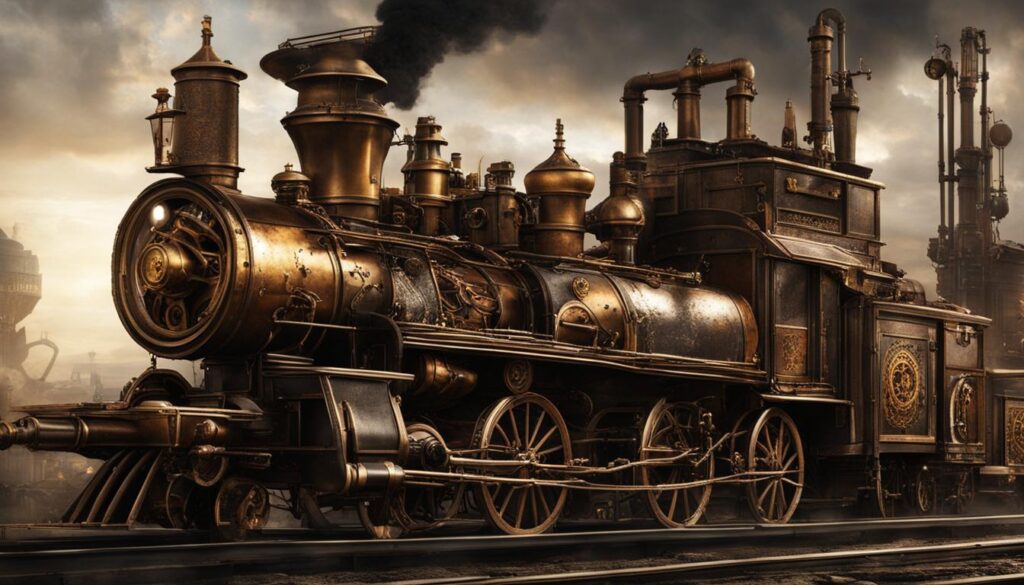
Steampunk Documentaries
For those seeking a deeper understanding of the steampunk genre, documentaries such as “Vintage Tomorrows” offer an in-depth exploration of its history, cultural impact, and significance. This documentary delves into the origins of steampunk, its evolution as a subculture, and its influence on popular culture. Through interviews with steampunk enthusiasts, artists, and scholars, “Vintage Tomorrows” provides a comprehensive look at the movement and its relevance in today’s world.
Steampunk’s influence extends beyond the realm of movies. It has permeated popular culture, inspiring TV shows and video games that incorporate its distinctive aesthetic and storytelling. From “Doctor Who” episodes featuring Victorian-era gadgets and characters, to video games like “Bioshock Infinite” that transport players to a steampunk-inspired city in the clouds, the genre continues to captivate and inspire audiences across different media platforms.
Steampunk’s Cultural and Societal Impact
Steampunk has left an indelible mark on culture and society, with its influence extending far beyond the realm of cinema. Its cultural significance lies in its ability to challenge norms and push boundaries, offering a unique perspective on technology and society. By embracing the past and rejecting the homogeneity of modern technology, steampunk provides an alternative vision of the future, one that prioritizes individuality and creativity.
One of the most notable impacts of steampunk is the sense of community it fosters. Steampunk conventions and events bring together like-minded individuals who share a passion for the subculture. These gatherings serve as a space for validation and connection, allowing participants to express their creativity and immerse themselves in a world of imagination. The emphasis on handmade craftsmanship and DIY culture within the subculture also promotes resourcefulness and originality, encouraging individuals to think outside the box and create unique works of art.
Steampunk’s influence extends beyond aesthetics and events. It has inspired the creation of a wide range of unique and personalized products, contributing to the growth of the maker movement. From intricate steampunk-themed jewelry to fully functional steam-powered gadgets, the subculture has sparked a wave of innovation and craftsmanship. This emphasis on individual expression and handmade craftsmanship resonates with those seeking a break from mass-produced, disposable goods, further fueling the appeal of steampunk.
The Societal Influence
“Steampunk invites us to question the direction of our society and consider the consequences of unchecked technological progress,” says renowned cultural critic Dr. Amelia Westwood. “By exploring themes of commodification and globalization, steampunk encourages us to reflect on our relationship with technology and envision alternative futures.”
This societal influence is perhaps most evident in the growing maker movement, where individuals embrace the ethos of steampunk by creating their own unique inventions and repurposing old technologies. This DIY culture empowers individuals to take control of their own technological narratives, fostering a sense of agency and self-reliance in an increasingly interconnected world. By rejecting the notion that technology must always be sleek and invisible, steampunk challenges our assumptions about progress and opens up new possibilities for what technology could look like.
In conclusion, steampunk’s impact on culture and society is far-reaching and multi-faceted. It offers a counterpoint to mainstream notions of technology and consumerism, encouraging individuality, creativity, and community. As the subculture continues to evolve and attract a wider audience, its influence will only continue to grow, inspiring new generations to imagine a world where the past meets the future in extraordinary style.
The Future of Steampunk in Cinema
Steampunk cinema has come a long way since its inception, and its future looks incredibly promising. As the genre continues to evolve, it is attracting a wider audience with its unique blend of history, fantasy, and innovation. Filmmakers are embracing steampunk aesthetics and storytelling, creating visually stunning worlds that captivate audiences. With advancing technology, the possibilities for intricate and immersive steampunk experiences on the big screen are limitless. The future of steampunk in cinema is bright and full of potential.
One of the reasons for the expanding audience of steampunk cinema is its ability to transport viewers to a world that is both familiar and fantastical. The genre’s retro-futuristic aesthetic, with its intricate gears, Victorian fashion, and steam-powered contraptions, creates a visually engaging experience. Steampunk movies offer a unique escape from reality, allowing audiences to indulge in an alternative history that sparks the imagination.
Another factor driving the future of steampunk in cinema is the genre’s ability to resonate with a wide range of viewers. Steampunk appeals to those who have a fascination with history, as well as those who enjoy science fiction and fantasy. Its themes of individuality, creativity, and resistance against the homogenization of technology strike a chord with people seeking a break from the modern world’s reliance on mass-produced, disposable objects. As the steampunk subculture continues to grow, so does its influence on mainstream media, making it an exciting and evolving genre to watch.
In conclusion, the future of steampunk in cinema is bright and promising. With its visually stunning worlds, unique blend of history and fantasy, and ability to resonate with a diverse audience, steampunk continues to captivate and inspire. As technology advances, filmmakers will have even more tools at their disposal to bring intricate steampunk universes to life, pushing the boundaries of visual storytelling. So, buckle up and get ready for a thrilling ride into a world where the past meets the future in extraordinary style.
| Key Points |
|---|
| Steampunk cinema is evolving and attracting a wider audience. |
| The genre’s unique blend of history, fantasy, and innovation captivates viewers. |
| Steampunk resonates with those seeking a break from modern technology and mass-produced objects. |
| Filmmakers have more tools at their disposal to bring intricate steampunk worlds to life. |
Conclusion
Steampunk has undeniably revolutionized modern cinema, leaving an indelible impact on the film industry. Its unique aesthetic, alternative history, and imaginative storytelling have captivated audiences worldwide. From influencing visual design and cinematography techniques to exploring themes of commodification, DIY culture, and globalization, steampunk has pushed the boundaries of creativity and challenged societal norms.
With its blend of nostalgia, fantasy, and innovation, steampunk has become a global phenomenon, appealing to people from all walks of life. It has inspired individuality, creativity, and a sense of community among its participants. Steampunk’s influence extends beyond the confines of cinema, infiltrating popular culture, fashion, and even the maker movement.
As the genre continues to evolve, we can expect to see a growing presence of steampunk in cinema. With advancements in technology, filmmakers now have the tools to bring intricate steampunk worlds to life in even more spectacular ways. The future of steampunk in cinema is bright, as it continues to attract a wider audience and inspire new generations of storytellers.
FAQ
What is steampunk?
Steampunk is a subculture that reimagines the history of the Industrial Revolution during Victorian era England, combining elements of the Victorian era, the Wild West, and steam-powered science fiction to create a unique aesthetic and storytelling style.
When did steampunk originate?
Steampunk originated in the 1900s as a subgenre of science fiction literature, focusing on clockwork mechanisms and nineteenth-century machinery and style.
What is the steampunk aesthetic?
The steampunk aesthetic is characterized by a combination of Victorian-era fashion and uncovered machinery, featuring corsets, top hats, goggles, and open-faced gears, hydraulics, and engines.
What are the themes explored in steampunk cinema?
Steampunk cinema explores themes such as commodification, DIY culture, and globalization, providing insight into the sociological significance of the subculture.
How has steampunk influenced modern cinema?
Steampunk has had a significant impact on modern cinema, influencing visual design, themes, and cinematography techniques used in movies.
What are some examples of steampunk movies?
Examples of steampunk movies include “Treasure Planet,” “Wild Wild West,” and “The League of Extraordinary Gentlemen.”
What is the cultural and societal impact of steampunk?
Steampunk has pushed boundaries and challenged norms, providing a sense of community and validation for participants, and inspiring creativity and individuality.
What can we expect for the future of steampunk in cinema?
The future of steampunk in cinema looks promising, as the genre continues to evolve and attract a wider audience, captivating viewers with its blend of history, fantasy, and innovation.

